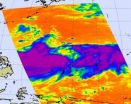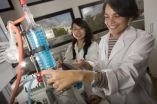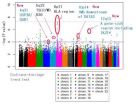(Press-News.org) PHILADELPHIA — Even in trace quantities, the radioactive gas radon is very dangerous; it is second only to cigarette smoking as a cause of lung cancer deaths in the United States. The expense and precautions necessary to study it safely have limited research into its properties. Now, University of Pennsylvania chemists have for the first time measured how well radon binds to a molecule, paving the way for future research on it and other noble gasses.
The research was led by associate professor Ivan J. Dmochowski, along with undergraduate Vagelos Scholar David R. Jacobson and graduate students Najat S. Khan and Yubin Bai of the Department of Chemistry in Penn's School of Arts and Sciences. Because radon is so difficult to generate and handle safely, the Penn team collaborated with researchers at the National Institute of Standards and Technology who have experience in that area.
Their work was published in the journal Proceedings of the National Academy of Sciences.
Dmochowski's research group has long studied how xenon, a gas chemically similar to radon, interacts with the organic molecule cryptophane. With its cage-like structure, different kinds of cryptophane excel at binding even the non-reactive noble gasses, of which xenon and radon are both members.
"We predicted that radon would bind slightly better than xenon, as xenon under-fills the cavity in the cryptophane, and radon is a little bit larger," Dmochowski said. "There is an attractive force between the noble gas atom and the cage, and, if you optimize that interaction by matching the size of the atom and the cage's volume, you can increase the affinity."
"Other researchers made previous measurements of radon's interaction with bulk materials, like charcoal or ice," Jacobson said. "But this is the first measurement of radon binding to a discrete molecule."
The team didn't measure individual radon atoms but rather a solution of radon and a new water-soluble cryptophane. The cryptophane was synthesized for the first time in their lab, but acquiring an appreciable amount of radon was a bigger challenge. Jacobson made several trips to the NIST facility in Maryland, where the experiment was conducted using NIST's standard method for safely generating and working with the element.
At the core of the method are capsules of another radioactive element, radium, which were developed by NIST researcher and co-author Ronald Collé. The team placed the capsules into sealed vials of water. As the radium decayed, the gaseous radon leached out. After a period of a few days, the researchers were left with a precise amount of radon dissolved in the water that was then carefully transferred into a series of sealed vials containing different amounts of cryptophane.
"Some of the radon eventually evaporates out of the liquid phase inside the sealed vessels," Jacobson said. "We showed that the amount that's left behind in the liquid phase is more when there's more cryptophane to hold it within the liquid."
Less free radon gas indicates that the element was binding to the cryptophane. To measure exactly how much radon was bound, the team used a process known as liquid scintillation.
"Because radon is radioactive, we can take the liquid and inject it into a cocktail that fluoresces when something undergoes radioactive decay," Jacobson said. "We then put that into a machine that counts the number of fluorescence incidents."
From that measurement, the team was able to determine radon's "affinity constant," a measure of how much radon was bound to cryptophane at a given temperature.
The principles behind making this determination could be used on different binding targets.
"Now that we have a robust method for measuring radon binding to discrete entities, we could apply it to things like proteins found in the lungs," Dmochowski said. "If you know radon's affinity for those proteins, you have a better idea of the concentration and timescale over which it will be dangerous."
Better radon-binders could be also used to extract the dangerous element from groundwater, for example, and the same principle could be used to harvest xenon from the atmosphere. Xenon is relatively safe and has a wide range of medical and industrial uses.
Dmochowski's group is interested in using xenon for making better MRI contrast agents, but the gas is also used in plasma televisions, lasers and ion propulsion systems for deep space satellites.
###
In addition to Dmochowski, Jacobson, Khan, Bai and Collé, Ryan Fitzgerald and Lizbeth Laureano-Pérez of NIST contributed to the research. Their work was supported by the Department of Defense, the National Institutes of Health and the National Science Foundation.
Penn chemists make first molecular binding measurement of radon
2011-08-01
ELSE PRESS RELEASES FROM THIS DATE:
Tropical Storm Muifa appears huge on NASA infrared imagery
2011-08-01
The width of an image from the AIRS instrument that flies on NASA's Aqua satellite is about 1700 km (1056 miles), and the clouds and thunderstorms associate with Tropical Storm Muifa take up that entire distance on today's imagery.
Tropical Storm Muifa is spinning through the western North Pacific Ocean today and has grown in size. When NASA's Aqua satellite passed over the storm on July 29, 2011 at 04:17 UTC (12:17 a.m. EDT) it measured the temperatures in the cloud tops. Those cloud top temperatures especially in the east and western sides of the tropical storm were ...
Tropical Storm Don analyzed in 3 NASA satellite images
2011-08-01
NASA is analyzing Tropical Storm Don from all angles, inside and out, using three different satellites. Don is expected to make landfall in southeastern Texas tonight or early Saturday.
NASA's Aqua satellite passed over Tropical Storm Don at 8:17 UTC (4:17 a.m. EDT) on July 29. The instrument called the Atmospheric Infrared Sounder (AIRS) took the temperature of Don's clouds in an infrared image. AIRS data revealed a large area of powerful, high thunderstorms with cold cloud tops surrounding Don's center where cloud temperatures were colder than -63 Fahrenheit (-52 Celsius). ...
AGU journal highlights -- July 29, 2011
2011-08-01
The following highlights summarize research papers that have been
recently published in Geophysical Research Letters (GRL); Space
Weather; Geochemistry, Geophysics, Geosystems (G-Cubed); Journal of Geophysical Research-Biogeosciences (JGR-G); Journal of Geophysical Research-Earth Surface (JGR-F); Journal of Geophysical Research-Space Physics (JGR-A) and Water Resources Research (WRR).
In this release:
What do sea measurements reveal about Earth's temperature trend?
Japan's big earthquake shook the ionosphere
Miniature detector measures deep space radiation
New ...
Computational chemistry shows the way to safer biofuels
2011-08-01
Replacing gasoline and diesel with plant-based bio fuels is crucial to curb climate change. But there are several ways to transform crops to fuel, and some of the methods result in bio fuels that are harmful to health as well as nature.
Now a study from the University of Copenhagen shows that it is possible to predict just how toxic the fuel will become without producing a single drop. This promises cheaper, faster and above all safer development of alternatives to fossil fuel.
Solvejg Jorgensen is a computational chemist at the Department of Chemistry in Copenhagen. ...
Discovery of a new magnetic order
2011-08-01
Physicists at Forschungszentrum Jülich and the universities of Kiel and Hamburg are the first to discover a regular lattice of stable magnetic skyrmions – radial spiral structures made up of atomic-scale spins – on a surface instead of in bulk materials. Such tiny formations could one day form the basis of a new generation of smaller and more efficient data storage units in the field of information technology. The scientists discovered the magnetic spirals, each made up of just 15 atoms, in a one-atomic-layer of iron on iridium. They present their results in the current ...
National asthma genetics consortium releases first results
2011-08-01
A new national collaboration of asthma genetics researchers has revealed a novel gene associated with the disease in African-Americans, according to a new scientific report.
By pooling data from nine independent research groups looking for genes associated with asthma, the newly-created EVE Consortium identified a novel gene association specific to populations of African descent. In addition, the new study confirmed the significance of four gene associations recently reported by a European asthma genetics study.
The findings, published in Nature Genetics, are a promising ...
Physics could be behind the secrets of crop-circle artists
2011-08-01
In this month's edition of Physics World, Richard Taylor, director of the Materials Science Institute at the University of Oregon, takes a serious, objective look at a topic that critics might claim is beyond scientific understanding – crop circles.
As the global crop-circle phenomenon grows alongside advances in science and technology, Taylor notes how physics and the arts are coming together to produce more impressive and spectacular crop-circle patterns that still manage to maintain their mystery.
Today's crop-circle designs are more complex than ever, with some ...
Dissecting the genomes of crop plants to improve breeding potential
2011-08-01
Scientists on the Norwich Research Park, working with colleagues in China, have developed new techniques that will aid the application of genomics to breeding the improved varieties of crop needed to ensure food security in the future. By dissecting the complicated genome of oilseed rape they have been able to produce maps of the genome that are needed for predictive breeding.
Traditional breeding involves crossing two varieties and selecting the best performing among the progeny. Predictive breeding is a more advanced technique where specific parts of the genome most ...
Columbia engineering innovative hand-held lab-on-a-chip could streamline blood testing worldwide
2011-08-01
New York, NY—July 31, 2011—Samuel K. Sia, assistant professor of biomedical engineering at Columbia Engineering, has developed an innovative strategy for an integrated microfluidic-based diagnostic device—in effect, a lab-on-a-chip—that can perform complex laboratory assays, and do so with such simplicity that these tests can be carried out in the most remote regions of the world. In a paper published in Nature Medicine online on July 31, Sia presents the first published field results on how microfluidics—the manipulation of small amounts of fluids—and nanoparticles can ...
Genome-wide study reveals 3 new susceptibility loci for adult asthma in Japanese population
2011-08-01
Researchers at the RIKEN Center for Genomic Medicine (CGM), together with colleagues at Kyoto University, Tsukuba University, Harvard University, and other medical institutions have identified three new loci associated with susceptibility to adult asthma in the Japanese population. The findings appear in Nature Genetics and derive from a genome-wide study of 4836 Japanese individuals.
Around the world, hundreds of millions of people suffer from bronchial asthma, a chronic inflammatory disease characterized by symptoms of wheezing, shortness of breath and coughing. In ...




